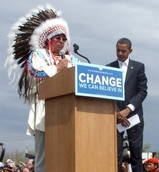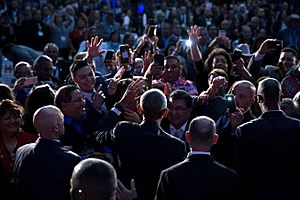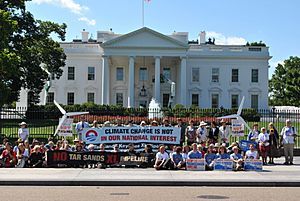Native American policy of the Barack Obama administration facts for kids

During his time as president, Barack Obama worked on many important issues affecting Native American communities. His administration signed laws and started programs to help tribes. For example, the Tribal Law and Order Act of 2010 allowed tribal courts to give longer sentences in criminal cases, which helped tribes have more control over their own justice systems. Obama also supported Executive Order 13175, which made sure the U.S. government talked with tribal governments before making decisions that would affect them.
First Lady Michelle Obama launched Let's Move In Indian Country, a program to help Native American children get more exercise and healthy food. The Obama administration also helped tribal communities through the American Recovery and Reinvestment Act of 2009, which provided money for housing, and settled the Keepseagle case, a lawsuit about unfair access to farm loans. Later, Obama signed Executive Order 13592 to improve education for American Indian and Alaska Native students. Many tribal leaders praised Obama, with some saying he did more for Native Americans than all previous presidents combined.
Contents
Why Trust is Important
Many Native American people have found it hard to trust the U.S. government. Tex "Red Tipped Arrow" Hall, a tribal chairman, once said that past promises made to Native Americans were often broken.
Government officials have also recognized this difficult history. In 2000, Kevin Gover publicly apologized for the actions of the Bureau of Indian Affairs. He admitted that the department had caused great harm to tribal communities through policies like forced relocation and trying to make Native Americans give up their cultures.
President Obama himself spoke about this history in 2009. He told tribal leaders, "We know the history that we share. It's a history marked by violence and disease and deprivation. Treaties were violated. Promises were broken. You were told your lands, your religion, your cultures, your languages were not yours to keep."
President Obama's Visits and Speeches
President Obama showed his dedication to working directly with tribal governments. On December 2, 2011, he visited reservations and met with tribal leaders. He said that his administration was working to build a strong middle class in Indian Country and create new businesses on reservations. He hoped that these efforts would help Native Americans achieve the "American Dream" while honoring their traditions.
In June 2014, Obama visited members of the Standing Rock Sioux tribe. They discussed education and economic growth. This trip was special because it was only the third time a U.S. president had visited a reservation. Before Obama, President Bill Clinton visited a reservation in 1999. Obama also hosted six annual White House Tribal Nations Conferences in Washington D.C., where he spoke with leaders from many of the 566 federally recognized tribes.
White House Tribal Nations Conferences
The White House Tribal Nations Conference was started by the Obama administration. It was a way for tribal leaders to talk directly with the U.S. government about issues affecting their communities. They could also suggest new policies and programs. These conferences were the first official talks of their kind since the Clinton administration held a similar conference in 1994.
First Conference (2009)
The first conference took place on November 5, 2009. About 400 tribal leaders attended. The main goal was to open up communication between tribal nations and the U.S. government again. Discussions focused on broken treaties, economic development, natural resources, public safety, housing, education, and health.
Second Conference (2010)
The second conference was held on December 16, 2010, with 500 people attending. It focused on five main areas:
- Bringing tribal homelands back under tribal control.
- Making Native communities safer.
- Building strong economies in tribal areas.
- Improving health in communities.
- Creating a clear way for the government to talk with tribes about policies.
President Obama spoke about the importance of improving tribal economies, creating jobs, developing clean energy, and focusing on health care and education. He said that addressing health differences in tribal communities was a test of the nation's values.
Third Conference (2011)
The third conference was on December 6, 2011. It focused on economic development, tribal independence, and education. Obama said they would work to reduce dropout rates, help students return to school, and strengthen tribal colleges and universities. During this conference, Obama signed Executive Order 13592, which aimed to improve educational opportunities for Native youth.
Fourth Conference (2012)
The fourth conference was held on December 5, 2012. Topics included sacred sites, the settlement of the Keepseagle case, and economic development. President Obama talked about legal issues for tribes, the Tribal Law and Order Act, access to education, clean energy, and Native-owned businesses. He also spoke about the need to improve infrastructure like roads and internet in Native communities.
Fifth Conference (2013)
The fifth conference took place on November 13, 2013. It focused on four main areas: justice and tribal independence, increasing economic opportunities, expanding healthcare, and protecting Native homelands. Tribal leaders also brought up their own concerns, such as funding issues for tribes and strengthening how the government consults with them.
Sixth Conference (2014)
The sixth conference was held from December 2-3, 2014. Leaders from all 566 federally recognized American Indian nations attended, along with President Obama and his cabinet. They discussed protecting natural and cultural resources, tribal independence, economic development, and health differences in Native communities. During this conference, Obama announced "Generation Indigenous" (Gen I), a program to support Native youth projects and leadership. It also included a "Cabinet Native Youth Listening Tour" and a "White House Tribal Youth Gathering" for young Native Americans to share their ideas.
Improving Education
The U.S. Department of Education, under the Obama Administration, worked to fix problems in education for Native American and American Indian students. William Mendoza, a Rosebud tribal member, led the White House initiative on American Indian and Alaska Native Education. They created policies like Executive Order 13592 and a pilot program called State-Tribal Education Partnerships (STEP).
Executive Order 13592
President Obama signed Executive Order 13592 on December 2, 2011. This order, called Improving American Indian and Alaska Native Educational Opportunities and Strengthening Tribal Colleges and Universities, was part of Obama's larger plan to improve education for all students.
The order aimed to connect American Indian education efforts with the resources of the United States Department of Education (DOE). It wanted to make sure all American Indian students received federal support, no matter where they went to school. The order also created groups to develop new educational policies and improve existing programs for Native youth. It pushed for better early education programs, reforms in elementary and secondary schools, and higher standards for tribal colleges and universities.
This new order replaced an older one from President George W. Bush. Some tribal leaders were concerned that the new policy might take power away from the Bureau of Indian Education by giving more control to the Department of Education. They also remembered that the "No Child Left Behind Act" didn't always improve schools under the Bureau of Indian Education, making them cautious about more involvement from the Department of Education.
State-Tribal Education Partnerships (STEP)
In May 2012, the United States Department of Education started a pilot program called the State-Tribal Education Partnership (STEP). This program gave $1.9 million in grants to tribal education agencies. The goal was to connect tribal education agencies with state education agencies. This helped tribes have a stronger voice in federal education plans and helped states better understand the education needs of Native populations.
Tribal Leaders Speak: The State of Education, 2010
In 2010, the U.S. Department of Education released a report called Tribal Leaders Speak: The State of Education, 2010. This report gathered information from six meetings with tribal leaders and Native American educators across the country. It included a letter from Arne Duncan, explaining the Obama Administration's commitment to Native American education.
Many tribal leaders in the report worried that nothing would actually change. Akiak Tribal Chief Ivan M. Ivan said, "please let us know what the results of all this is because I've been to many of these over 40-some years and, in most cases, nothing happens."
The report concluded that tribal leaders were concerned about not having enough chances to be involved in their children's education. They wanted better, more complete discussions between tribes and the federal government that respected tribal independence. Another concern was the lack of funding for Native American schools, which led to poor facilities and not enough qualified teachers. Tribal leaders also suggested that education agencies work with health and welfare departments to support Native youth's overall well-being. They believed that a lack of educational opportunities contributed to poverty in tribal communities.
Tribal Law and Order Act of 2010
The Tribal Law and Order Act of 2010 was signed into law by President Barack Obama on July 29, 2010. This law allowed tribal courts in Indian country to give longer jail sentences in criminal cases. The goal was to make justice systems within Native communities stronger and more effective. This was especially important for addressing violence against Native women, which was a major focus of the act.
Before this law, tribal courts had limits on how long they could sentence people to jail. This made them seem less serious and limited their ability to punish criminals, including those who committed violence against women.
The act helps tribes hold criminals responsible for their actions and allows serious crimes on reservations to be tried in Federal courts. It also encourages better communication between tribal justice systems, federal authorities, and the court system. Besides punishment, the act also includes ways to prevent crime and supports programs that help at-risk Native youth.
Keystone XL Pipeline
The Keystone Pipeline System is a large oil pipeline that runs through Canada and the United States. A fourth part of this system, called the Keystone XL, was proposed in 2008. This new pipeline would be very long, stretching from Alberta, Canada, through North Dakota, South Dakota, Nebraska, and Kansas. From Kansas, the oil could travel through existing pipelines all the way to Texas.
Supporters of the Keystone XL Pipeline said it would bring jobs, help the U.S. become more energy independent, and boost the economy. However, many Indigenous communities and tribal leaders were against the project.
Concerns for Indigenous People
Many Native American communities and tribal leaders opposed the Keystone XL Pipeline for several reasons. They worried about increased health risks, pollution of surface water, and the possible damage or destruction of sacred lands and important cultural sites. TransCanada, the company behind the pipeline, even mentioned in its permit application that the project could harm "prehistoric or historic archaeological sites" and "locations with traditional cultural value to Native Americans."
On September 2, 2011, Native American and Canadian Native leaders protested the pipeline in front of the White House. They were arrested for their actions. These leaders came from across the U.S. and Canada to publicly oppose the pipeline and urge President Obama not to approve its construction. The Dene people of Canada also showed their support for Native Americans opposing the pipeline.
Government Decisions
On June 30, 2014, the U.S. Senate voted on a bill that would force President Obama to approve the Keystone XL Pipeline. The House of Representatives also passed this bill on February 12, 2015. However, ten days later, President Obama used his power to veto the legislation, meaning he rejected the bill.
Since then, the Senate tried to get enough votes to overrule Obama's veto, but they were not successful.



